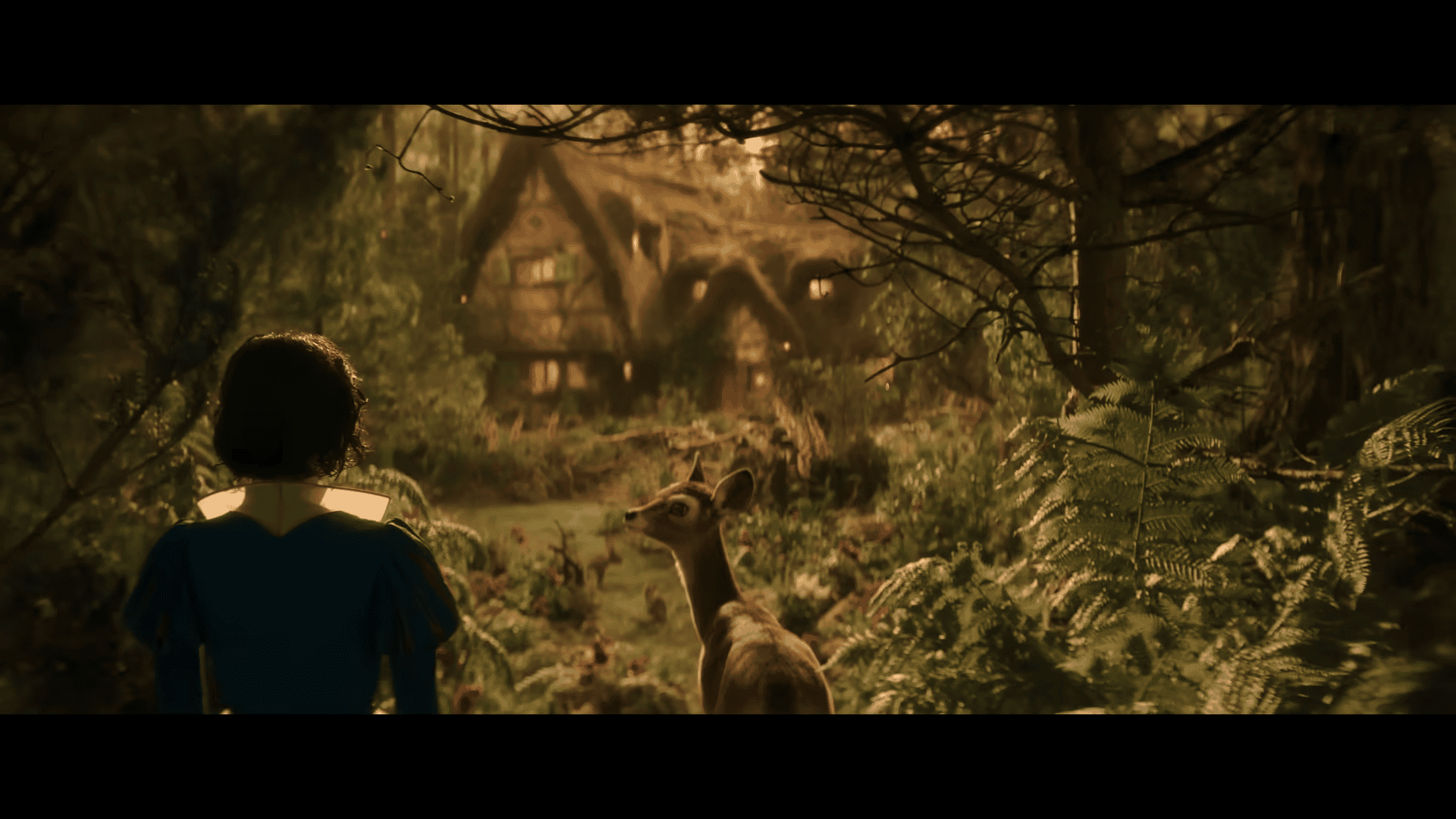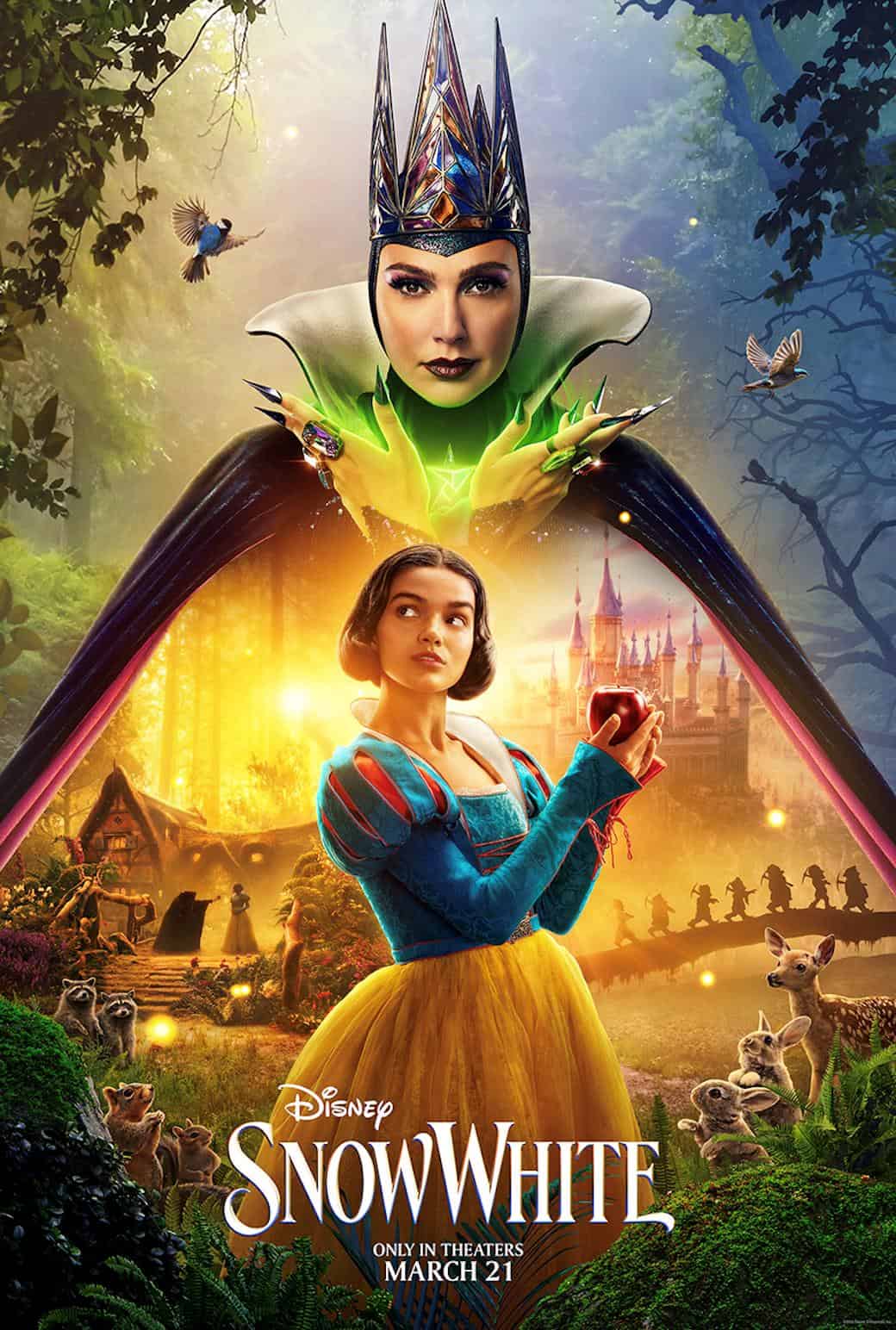
Disney’s live-action remake of “Snow White” is currently tracking for a mediocre opening weekend at the box office. According to updated projections from industry research firms, the film starring Rachel Zegler is expected to debut with domestic earnings between $48-58 million, with the most likely figure landing around $53 million. These numbers represent a significant disappointment for Disney, especially considering the high production costs typically associated with their live-action remakes.
The projected opening falls well short of expectations for a major Disney release based on one of their most iconic properties. This underwhelming forecast comes despite the film’s recognizable IP and the studio’s marketing efforts. The lower-than-hoped-for numbers suggest potential audience hesitation that could impact the film’s long-term performance.
Industry analysts are closely watching this release as it may indicate shifting audience preferences regarding Disney’s strategy of reimagining animated classics. Universal’s “Snow White and the Huntsman,” a different take on the fairy tale released years ago, opened in a similar range between $48-52 million, though market conditions and audience expectations were considerably different at that time.

Production Challenges and Delays
Disney’s live-action adaptation of Snow White has faced a series of production hurdles since its inception. Initially slated to begin filming in March 2020, the project experienced delays due to the COVID-19 pandemic. Principal photography eventually commenced in March 2022 at Pinewood Studios in the United Kingdom. However, the set encountered a significant setback when a fire broke out during construction, causing further delays. Despite these challenges, the team persevered, completing the primary filming phase by July 2022. Additional scenes and reshoots were conducted in June 2024 to ensure the film met Disney’s high standards.
Casting Choices and Controversies
The casting decisions for Snow White have sparked extensive discussions and debates. Rachel Zegler, known for her role in West Side Story, was chosen to portray the iconic princess. Her selection marked a progressive step towards inclusivity, reflecting Disney’s commitment to diverse representation. However, this choice also ignited conversations about staying true to the original character’s depiction.
Gal Gadot, famed for her portrayal of Wonder Woman, takes on the role of the Evil Queen. Gadot expressed enthusiasm about exploring a character vastly different from her previous roles, describing the experience as both “fun and delicious.” Her involvement adds a compelling dynamic to the film, promising a fresh take on the classic villain.
Modernizing a Classic Tale
In reimagining Snow White for contemporary audiences, the filmmakers aimed to balance respect for the original 1937 animated classic with modern sensibilities. Screenwriters Greta Gerwig and Erin Cressida Wilson infused the narrative with depth, focusing on themes of empowerment and self-discovery. The character of Snow White is portrayed as a strong, self-sufficient leader, moving beyond the traditional damsel-in-distress trope.
The film also introduces new musical elements, with composers Benj Pasek and Justin Paul crafting original songs to complement the timeless melodies of the original score. This blend of classic and new aims to resonate with both longtime fans and newcomers to the story.
Box Office Projections and Industry Expectations
As Snow White approaches its March 21, 2025 release date, industry analysts have been closely monitoring its box office potential. Early projections estimated an opening weekend gross between $65 million and $85 million. However, recent forecasts have adjusted these figures downward, with current expectations around $53 million. This shift may be attributed to various factors, including market competition and audience reception to pre-release materials.
Despite these projections, Disney remains optimistic. The studio’s strategy of revitalizing beloved classics has historically yielded positive results, and they anticipate that Snow White will continue this trend by captivating a new generation of viewers.
Key Takeaways
- Disney’s “Snow White” remake is tracking for an opening weekend of $48-58 million domestically, below expectations for a major studio release.
- The modest projections suggest potential audience fatigue with live-action remakes despite the film starring Rachel Zegler as the iconic princess.
- Box office performance of this film could influence Disney’s strategy for future live-action adaptations of their classic animated films.
Overview of ‘Snow White’ Release
Disney’s live-action Snow White embodies a fusion of tradition and innovation. Through thoughtful casting, a refreshed narrative, and musical reinvention, the film seeks to honor its legacy while offering a story that resonates in today’s world. As the release date approaches, audiences worldwide eagerly await this reimagined fairy tale, poised to experience the magic anew.
Disney’s live-action adaptation of “Snow White” is scheduled for theatrical release on March 21, 2025. The film, directed by Marc Webb, stars Rachel Zegler in the titular role alongside Gal Gadot as the Evil Queen.
Reception and Expectations
Initial box office projections for “Snow White” have been steadily declining as the release date approaches. Earlier forecasts predicted an opening weekend in the $65-$85 million range, positioning it as a potentially strong performer for Disney. However, recent tracking data has adjusted these expectations downward.
The latest projections from industry analysts suggest the film will likely open between $48 million and $58 million domestically. Some reports specifically point to approximately $53 million for the opening weekend, which falls well below original estimates.
This downward trend in predictions has raised concerns about the film’s commercial viability. The musical fantasy remake represents a significant investment for Disney as it continues its strategy of reimagining classic animated films for modern audiences.
Comparative Analysis with Past Productions
When compared to Disney’s previous live-action adaptations, “Snow White” appears to be tracking below average. The projected $53 million opening would place it significantly behind similar Disney remakes from recent years.
For context, “Maleficent” opened to approximately $69.4 million in 2014, while “Cinderella” achieved $67.8 million. These comparisons highlight a concerning gap for “Snow White” despite inflation and increased ticket prices over the years.
The film follows three months after Disney’s release of “Mufasa: The Lion King,” another reimagining from the studio’s classic animation catalog. This timing may impact audience enthusiasm, as Disney has been releasing multiple live-action adaptations in close succession.
“Snow White” holds special significance as it’s based on Disney’s first-ever animated feature film, creating both opportunities and challenges for this modernized version.
Financial Projections and Performance
Disney’s live-action “Snow White” remake faces concerning box office projections that suggest a significant underperformance compared to previous Disney remakes. Recent tracking shows a downward trend in expected opening weekend numbers.
Domestic Box Office Potential
The latest projections from industry research firms indicate “Snow White” is tracking for an opening weekend of approximately $53 million in North America. The estimated range has recently fallen to between $48 million and $58 million, down from earlier projections of $65-$85 million.
This represents a substantial decline from initial expectations and positions the film well below other successful Disney live-action remakes. For comparison, “The Lion King” opened to $191.7 million domestically, while “Beauty and the Beast” debuted with $174.7 million.
The dramatic reduction in projections suggests growing audience apathy toward the film. Marketing challenges have reportedly contributed to diminished excitement for the release.
Worldwide Earnings Outlook
Global performance prospects for “Snow White” appear modest compared to Disney’s previous remake successes. The film’s trajectory seems closer to “Maleficent” (2014), which opened at $69.4 million domestically but managed to reach $758.5 million worldwide.
However, it’s worth noting that “Maleficent’s” sequel failed to turn a profit despite the original’s success. This pattern raises concerns about “Snow White’s” long-term earnings potential.
Box office analysts point to several factors affecting the film’s international appeal:
- Weakening audience interest in Disney’s live-action remake strategy
- Marketing issues that have failed to generate sufficient anticipation
- Potential competition from other major releases in the same timeframe
Break-Even Analysis
With “Snow White’s” production budget likely in the typical range for Disney live-action remakes ($150-200 million) plus significant marketing expenses, the break-even point presents a challenging target. The film would need to generate approximately $400-500 million globally to approach profitability.
At the current projected opening of $53 million domestically, “Snow White” would need exceptional staying power and strong international performance to reach this threshold. The film’s box office multiplier (total gross divided by opening weekend) would need to exceed industry averages.
Disney’s strategic pivot toward streaming could provide additional revenue avenues beyond theatrical release. However, the projected underperformance would still represent a significant setback for Disney’s remake strategy.
Critical and Public Reception
The upcoming Snow White live-action remake has generated mixed reactions from critics and audiences ahead of its release. Early projections suggest audience interest may not align with Disney’s expectations for this reimagining of their first animated feature film.
Reviews and Critical Scores
While comprehensive critic reviews aren’t yet available for Snow White, industry insiders are closely watching how the film will be received. Disney’s recent live-action remakes have shown variable critical reception on platforms like Rotten Tomatoes.
Previous Disney remakes such as Maleficent earned mixed critical scores but found audience support. The Snow White production has faced scrutiny throughout its development cycle, with public discourse surrounding creative directions and casting choices.
Critics will likely evaluate how the film balances honoring the 1937 classic while updating elements for modern audiences. The direction by Marc Webb, known for (500) Days of Summer, may bring a fresh perspective to the familiar tale.
Audience Anticipation and Reactions
Public anticipation for Snow White appears lukewarm based on box office projections. Initially expected to open between $65-85 million domestically, newer forecasts suggest a significantly lower range of $48-58 million according to a leading Hollywood research firm.
Rachel Zegler’s casting as Snow White and Gal Gadot as the Evil Queen has generated substantial social media discussion. The film’s success will ultimately depend on word-of-mouth reactions during opening weekend.
Audience scores will prove crucial for Snow White’s long-term performance. CinemaScore ratings from opening weekend viewers often predict a film’s staying power at the box office better than critical reviews alone.
Disney faces the challenge of attracting families while satisfying fans of the original animated classic. The downward trend in box office projections may indicate hesitation from potential viewers about this particular adaptation.
Marketing and Publicity Efforts
Disney has shifted its marketing strategy for Snow White in response to concerning box office projections, now including more footage from the original animated classic in promotional materials while managing ongoing PR challenges.
Trailer Impact and Social Media Buzz
The Snow White marketing campaign has faced significant challenges in generating positive buzz. Initial trailers sparked mixed reactions across social media platforms, with many fans expressing concerns about the film’s creative direction. Disney has recently pivoted their strategy to include more footage and visual references to the beloved 1937 animated classic in newer promotional materials.
This shift comes as a direct response to audience feedback and declining box office projections. The studio hopes that connecting the new film more explicitly to its iconic predecessor will resonate better with nostalgic audiences and traditional Disney fans.
Social media sentiment analysis shows the film continues to face an uphill battle in terms of public perception, particularly surrounding star Rachel Zegler’s previous comments about the original film.
Promotional Activities and Brand Partnerships
Disney’s promotional strategy for Snow White includes standard tie-ins with major retailers and food brands, though with apparently less robust partner support than previous live-action remakes received. The studio has invested heavily in marketing, with reports suggesting a budget between $100-200 million dedicated to promotion alone.
The marketing campaign must overcome significant hurdles, including:
- Managing ongoing PR issues related to cast statements
- Justifying the film’s massive $269.4 million production budget
- Differentiating this version from previous Snow White adaptations
- Attracting family audiences in a competitive release window
Disney has utilized theme park integrations and exclusive merchandise collections to boost visibility. Special preview events at Disney parks have been scheduled to generate early word-of-mouth ahead of the March 2025 release date.
Cross-promotional efforts with Disney+ are also underway, making the original animated film more prominent on the streaming service to remind audiences of the story’s legacy.
Contextual Industry Analysis
Disney’s live-action Snow White faces significant headwinds in today’s theatrical marketplace. The projected opening weekend of $48-58 million falls below expectations for a major Disney release and signals potential challenges ahead.
Current Cinematic Landscape
The theatrical market in early 2025 shows mixed recovery signals. Big franchise films continue to dominate, with audience preference clearly leaning toward established IP with positive word-of-mouth.
Disney’s recent remakes have demonstrated inconsistent performance patterns. While some classics-turned-live-action have crossed the $1 billion mark globally, others have struggled to recoup their production budgets.
Box office analysts note the $63-70 million tracking for Snow White (per Quorum) represents a concerning downturn compared to similar Disney remakes. For comparison, 2014’s Maleficent opened at $70 million, equivalent to over $92 million in today’s dollars.
Pandemic Era Considerations
Theater attendance remains below pre-2020 levels in many markets. This ongoing recovery phase has created unpredictable patterns in audience behavior and spending.
Family films have faced particular challenges in the post-pandemic era. Parents remain somewhat hesitant to bring young children to theaters for non-event films, preferring to wait for streaming releases.
The shortened theatrical window—now typically 45 days before digital release—has changed viewer calculations about which films merit immediate theater viewing. High-concept spectacles and horror films have benefited from this shift, while mid-budget family films often struggle.
Disney’s streaming focus has also potentially diminished the “must-see” theatrical status of their live-action remakes.
Competing Films and Release Schedule
Snow White faces a crowded release calendar with strong competition for family audiences:
- Mufasa: The Lion King releasing just three months prior may cause Disney remake fatigue
- Warner Bros has strategically positioned Godzilla vs. Kong in the adjacent release corridor
- Several other major studio tentpoles target similar demographics in the surrounding weeks
The March release date positions Snow White outside prime summer or holiday windows when family films traditionally perform best. This timing creates additional pressure on opening weekend numbers.
Industry analysts suggest Disney may have overcrowded its own release schedule, potentially cannibalizing audience interest across its different properties.
Cast and Crew Insights
The live-action Snow White remake features a star-studded cast led by Rachel Zegler in the titular role, with notable performances and creative decisions that have sparked both interest and controversy during production.
Leading Roles and Casting Choices
Rachel Zegler leads the cast as Snow White, bringing a fresh interpretation to the iconic character. Her casting generated significant attention when first announced, with some audiences expressing enthusiasm for her talents while others voiced concerns about changes to the traditional portrayal.
Gal Gadot takes on the role of the Evil Queen, bringing her considerable star power to the film’s antagonist. The supporting cast includes the dwarves, though Disney’s approach to these characters has reportedly been revised from the 1937 animated classic.
The casting choices represent Disney’s modern vision for the story while attempting to maintain connections to the beloved original. Some of these decisions have contributed to the mixed pre-release reception that may be affecting box office projections.
Directorial Vision and Crew Contributions
The production team has faced challenges balancing nostalgia with contemporary storytelling approaches. The film’s significant budget—reportedly over $270 million—indicates substantial investment in visual effects, costume design, and elaborate set pieces.
The crew has worked to create a visually striking world that honors the first Disney animated feature while introducing new elements. Production delays pushed the release date to March 21, 2025, giving the team additional time to refine the final product.
Behind-the-scenes creative decisions have sometimes made headlines, particularly regarding the film’s approach to themes and characterization. The directorial vision appears to aim for a more modern interpretation of the classic fairy tale, potentially influencing audience expectations and contributing to the modest box office tracking.
Cultural Significance and Impact
Snow White has profoundly shaped cinema history and global cultural narratives since its 1937 debut as Disney’s first full-length animated feature. Its influence extends far beyond box office numbers, establishing storytelling patterns and artistic standards that continue to resonate today.
Legacy of the ‘Snow White’ Tale
The original 1937 Snow White film transformed animation from simple entertainment into a serious artistic medium. Released during the Great Depression, the film grossed over $8 million, becoming the highest-grossing film of its time. This financial success proved animation could be commercially viable at feature length.
Snow White’s cultural footprint crosses generations and borders. The film pioneered Disney’s signature approach to adapting classic fairy tales, establishing character archetypes and narrative structures that would define family entertainment for decades.
The story’s themes of jealousy, beauty, and resurrection continue to resonate across diverse cultures. Snow White became more than a character—she evolved into a cultural icon represented in countless products, theme park attractions, and adaptations.
Influence on Modern Cinema and Media
Snow White revolutionized animation techniques with innovations in multi-plane camera work, character movement, and emotional storytelling. These technical achievements set standards that influenced generations of filmmakers across all genres.
The film’s success created the template for the “Disney Princess” phenomenon, establishing storytelling patterns and character types that continue to drive billion-dollar franchises today. Its songs, including “Someday My Prince Will Come” and “Heigh-Ho,” became cultural touchstones.
Modern reimaginings of Snow White reflect changing social values. Contemporary adaptations frequently subvert the original’s gender roles and beauty standards, demonstrating how the tale adapts to evolving cultural conversations.
The enduring fascination with Snow White has spawned diverse interpretations across media platforms, from traditional animation to live-action films, television series, and digital content, proving its remarkable adaptability to new technologies and audience expectations.
International Market Considerations
While Disney’s Snow White remake faces modest domestic projections, the international markets will likely play a crucial role in determining the film’s overall commercial success. Foreign territories often respond differently to Disney’s live-action remakes, with some markets showing stronger enthusiasm than North American audiences.
Performance Predictions in Key Territories
China represents a potentially lucrative market for Snow White, though recent Disney remakes have shown diminishing returns there. Analysts predict the film might generate $15-20 million in its opening weekend in China, significantly lower than previous Disney remakes.
Japan and South Korea could perform better, as these markets have historically embraced Disney’s fantasy offerings. Japan might contribute $8-10 million in opening weekend revenues, while Korea could add $5-7 million.
In Europe, the UK is expected to be the strongest performer with projections of $7-9 million for opening weekend. Germany, where fairy tales originate and hold cultural significance, could deliver $4-6 million despite some controversy surrounding the adaptation.
Localization and Cultural Appeal
Disney has invested heavily in localization efforts for Snow White, creating market-specific promotional materials that highlight the universal aspects of the story. The film will release dubbed in 45 languages with subtitles in 28 more, reflecting Disney’s commitment to global accessibility.
The original fairy tale’s European roots may boost interest in markets like Germany, France, and Italy. However, some cultural critics have questioned how the modernized storyline will translate across different cultural contexts.
Asian markets present a mixed opportunity. While Disney princesses have strong appeal in Japan, the film’s reported deviation from the classic story might impact its reception in more traditional markets. China’s audience response will largely depend on how the film balances familiar fairy tale elements with its contemporary approach.
Legal and Ethical Discussions
Disney’s live-action “Snow White” has sparked several controversies beyond box office projections, raising questions about creative liberties and rights management in modern film adaptations.
Controversies Surrounding the Production
The remake has faced significant backlash from different angles. David Hand, son of the 1937 animation’s original director, publicly criticized Disney’s new approach, calling it a “disgrace” and lamenting the lack of respect for the original work’s success. This sentiment reflects wider concerns about cultural preservation versus modern reinterpretation.
The representation of Snow White’s friends became another flashpoint. Initial plans to replace the traditional seven dwarfs with one character with dwarfism and others of various ethnicities drew intense criticism on social media after set photos leaked. Disney subsequently revised their approach following the public outcry.
Lead actress Rachel Zegler’s comments about modernizing the story also generated controversy, with some fans questioning changes to the classic narrative structure and themes.
Intellectual Property and Rights Issues
Though Disney owns rights to their 1937 animated version, the original Snow White story exists in the public domain, creating complex intellectual property considerations. This legal status allows Disney creative freedom while still being constrained by audience expectations of their specific adaptation.
The substituted judgment concept, which has legal precedent, enters discussions around Snow White’s portrayal. In the original story, the dwarfs act as her caregivers and make decisions on her behalf, raising questions about consent and agency in both the original tale and modern interpretation.
Disney must navigate these rights issues carefully, balancing creative freedom against potential accusations of inappropriately altering a beloved classic. The PG rating expected for the film suggests Disney aims for family accessibility while addressing these modern ethical considerations.
Historical Box Office Trends
Disney’s live-action remakes have shown varied performance over the years, with some becoming massive blockbusters while others struggled to meet expectations. The projected $48-58 million opening for Snow White places it significantly below many of Disney’s previous remake successes.
Comparison with Similar Genres and Titles
Disney’s most successful live-action remakes have historically opened far stronger than Snow White’s projections. Beauty and the Beast debuted with an impressive $174.7 million, while The Lion King reached an extraordinary $191.7 million in its opening weekend. Aladdin performed well with $91.5 million, and Alice in Wonderland brought in $116.1 million.
More modest performers include Cinderella, which opened at $67.8 million in 2015. The Little Mermaid debuted at $95.5 million but faced diminishing returns in subsequent weeks. Even Maleficent, focusing on a villain rather than a princess, managed a $69.4 million opening.
The fantasy adventure genre has generally performed well for Disney, though audience fatigue may be setting in after numerous remakes.
Evolving Audience Interests and Behaviors
Viewer preferences have shifted significantly since Disney began its remake strategy. Family audiences now have more entertainment options competing for their attention, including streaming services with exclusive content.
Social media buzz can heavily influence opening weekend numbers. Films like Captain Marvel faced online controversy but still managed strong openings ($153.4 million), showing that negative publicity doesn’t always hurt box office results.
Horror-tinged fantasy films have gained popularity, with darker reimaginings attracting older audiences. Snow White’s more traditional approach may not tap into this trend.
Post-pandemic viewing habits continue to evolve, with audiences becoming more selective about theatrical experiences. Many families now wait for streaming releases rather than paying premium prices for theater tickets.
Frequently Asked Questions
The upcoming Snow White remake has generated considerable discussion among film enthusiasts and industry analysts. Box office projections suggest a modest opening, while controversies surrounding cast statements have impacted public perception.
What are the projected box office earnings for the Snow White remake?
Current tracking estimates place Snow White’s opening weekend earnings between $63-70 million according to Quorum, though some sources suggest a range of $65-85 million. These projections position the film comparable to Disney’s 2014 release Maleficent, which opened at $69.4 million.
The March 21, 2025 release date gives Disney a strategic position in the spring movie calendar, potentially allowing for sustained earnings beyond opening weekend.
What factors might contribute to the modest opening projections for Snow White?
Public controversy surrounding lead actress Rachel Zegler’s statements has created marketing challenges for Disney. These comments have made it difficult for some potential viewers to embrace the film.
Disney’s conspicuous omission of Snow White from recent earnings reports has raised questions about the studio’s confidence in the project.
The film’s release timing follows just three months after Mufasa: The Lion King, potentially creating Disney remake fatigue among audiences.
What is the production budget for the latest rendition of Snow White?
The production budget for Snow White is reportedly around $200 million. This significant investment represents Disney’s continued commitment to high-budget live-action adaptations of their animated classics.
The substantial budget covers elaborate visual effects, costume design, and the creation of fantasy environments that bring the classic tale to modern audiences.
Which elements of the Snow White film have led to public controversy?
Comments from lead actress Rachel Zegler have generated significant backlash. Her statement that “half the U.S. never know peace” created tension with potential viewers.
The reimagining of classic elements has divided fans, with some expressing concern about deviations from the original 1937 animated film.
The balance between honoring tradition and embracing modern storytelling approaches has been a persistent point of contention throughout the production process.
What is the expected impact of critical reviews on Snow White’s box office performance?
Critics’ reviews will likely play a crucial role in determining whether the film can exceed its modest opening projections. Positive reviews could help overcome existing controversies.
Family audiences tend to be influenced by reviews more than some other demographics, making critical reception particularly important for this Disney release.
The film’s performance in subsequent weeks will depend heavily on word-of-mouth and critical consensus.
How does Gal Gadot’s compensation compare with previous Snow White portrayals?
While exact figures for Gal Gadot’s compensation for her role as the Evil Queen remain undisclosed, industry analysts estimate her payment likely falls in the $8-12 million range.
This represents a significant increase compared to voice actors from the original 1937 animated version, who typically earned modest salaries by today’s standards.
Gadot’s star power, particularly following her success in the Wonder Woman franchise, commands a premium rate for antagonist roles in major studio productions.






